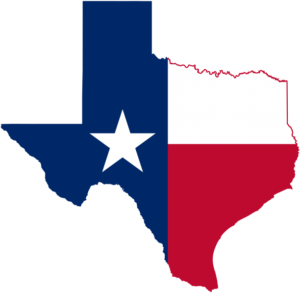
By AnonMoos based on image by Darwinek CC BY-SA 3.0
Federal judge strikes down restrictive Texas drone law
By Jim Magill
A federal judge has struck down a Texas drone law, one of the most restrictive in the country, for violating the First Amendment’s protections of freedom of speech and the press.
U.S. District Judge Robert Pitman on March 28 ruled that Chapter 423 of the Texas Government Code was unconstitutional and could not be enforced by any government or police entity. The law, which was passed in 2013 and later amended, had restricted the use of drones to collect images of private property, or to conduct “surveillance” of individuals.
The law was challenged by the National Press Photographers Association (NPPA), the Texas Press Association (TPA) and three Texas-based photojournalists, who successfully argued that the law improperly prohibited the use of drones to collect images used for newsgathering purposes. Chapter 423 included exceptions, allowing drone photography and videography for other purposes, such as surveying, real estate work and academic research, but notably not for news reporting.
In an interview Mickey Osterreicher, NPPA’s general counsel, said the strong ruling would likely affect laws restricting the use of UAVs in other states.
“We’re very pleased with it and we also hope it will send a message to other states and municipalities to dissuade legislators from enacting unconstitutional laws,” he said. “We’ve seen other cases where the courts have struck down similar laws in municipalities, but this is the first time that a state law has been struck down as unconstitutional.”
Attorneys for the plaintiffs in the case had argued that the law has had a chilling effect on the use of drones to collect images for journalistic purposes. They pointed out that The Dallas Morning News had adopted a policy against the use of UAV-captured photos to avoid running afoul of Chapter 423.
The photojournalists, all certified Part 107 drone pilots, also described how the law had prevented them from using UAVs in their work.
In 2018, journalist Guillermo Calzada, a video journalist with the San Antonio Express-News was flying his UAV to capture images of the effects of an arson fire at an apartment complex in San Marcos, Texas, when he was stopped by agents from the Bureau of Alcohol, Tobacco, Firearms and Explosives (ATF). The ATF agents called San Marcos police, who told Calzada that he could “face criminal penalties under Chapter 423 if he continued to use his UAV to report on the fire or published any of the captured images,” according to the judge’s ruling.
Calzada testified that after that incident he stopped using his drone in his news reporting, because of his fear of prosecution under Chapter 423.
Photographer Brandon Wade testified that he was unable to use his drone to take aerial images of Globe Life Park in Arlington, Texas for newsgathering purposes even though he was hired by the Texas Rangers “to take the very same images for their own public relations purposes,” according to the ruling.
Photojournalist Joseph Pappalardo said that because of the law, he had foregone opportunities to report on “events related to Hurricane Harvey, the removal of homeless encampments, the way gridlock hampers emergency responders and illegal poaching in urban areas.”
In his decision, Judge Pitman ruled that allowing the use of drone photography and videography for some uses, but not others such as news gathering, amounted to a content-based restriction, which is impermissible under the First Amendment.
Issues with Texas drone law no-fly and surveillance provisions
Pitman also found problems with other provisions of the law, including the so-called “no-fly provisions, which imposed criminal penalties by making it unlawful to fly UAVs over a correctional facility, detention facility, or critical infrastructure facility or sports venue at less than 400 feet.
Critical infrastructure facilities were defined to include oil and gas pipelines, petroleum and alumina refineries, water treatment facilities, and natural gas fractionation and chemical manufacturing plants. In 2017, that state legislature expanded the scope of critical infrastructure to include animal-feeding operations, oil and gas drilling sites and chemical production facilities, among others.
The 2017 amendments also defined a “sports venue” to include any arena, stadium, automobile racetrack, coliseum, or any other facility that has seating capacity of more than 30,000 people and is “primarily used” for one or more professional or amateur sport or athletics events.
The plaintiffs argued that combined with FAA regulations, which require UAVs to fly below 400 feet, the no-fly provisions effectively ban the use of drones at the listed locations. They also successfully argued that some of the no-fly provisions did not accomplish the goals for which they had been intended. For example, the provision for flying over stadiums, allegedly intended to ensure safety by prohibiting drone flights over crowds of people, does not distinguish between drone flights over packed stadium on game day and flying over an empty stadium in the middle of the week.
In addition to the other reasons he cited for finding the law unconstitutional, Pitman ruled that the surveillance and no-fly provisions should be struck down because of vagueness of the language of the law.
One section of the law imposes criminal and civil penalties by declaring it unlawful to use “an unmanned aircraft to capture an image of an individual or privately owned real property . . . with the intent to conduct surveillance on the individual or property captured in the image.” However, the law does not define the word “surveillance,” and the judge noted that the word could include in its sweep legitimate newsgathering activities.
The plaintiffs successfully argued that surveillance clause “effectively outlaws the use of UAVs for newsgathering on private property—constituting 95 percent of the state,” the ruling states. The surveillance clause also prohibits the use of drones to perform tasks that otherwise would be legal if accomplished by any other means, the judge writes.
The surveillance provisions “prevent journalists from using drones to record many scenes that could be recorded from a helicopter, or that anyone standing on public property could easily see and record.”
Read more about Texas state drone laws and the Texas drone industry:
 Jim Magill is a Houston-based writer with almost a quarter-century of experience covering technical and economic developments in the oil and gas industry. After retiring in December 2019 as a senior editor with S&P Global Platts, Jim began writing about emerging technologies, such as artificial intelligence, robots and drones, and the ways in which they’re contributing to our society. In addition to DroneLife, Jim is a contributor to Forbes.com and his work has appeared in the Houston Chronicle, U.S. News & World Report, and Unmanned Systems, a publication of the Association for Unmanned Vehicle Systems International.
Jim Magill is a Houston-based writer with almost a quarter-century of experience covering technical and economic developments in the oil and gas industry. After retiring in December 2019 as a senior editor with S&P Global Platts, Jim began writing about emerging technologies, such as artificial intelligence, robots and drones, and the ways in which they’re contributing to our society. In addition to DroneLife, Jim is a contributor to Forbes.com and his work has appeared in the Houston Chronicle, U.S. News & World Report, and Unmanned Systems, a publication of the Association for Unmanned Vehicle Systems International.
Miriam McNabb is the Editor-in-Chief of DRONELIFE and CEO of JobForDrones, a professional drone services marketplace, and a fascinated observer of the emerging drone industry and the regulatory environment for drones. Miriam has penned over 3,000 articles focused on the commercial drone space and is an international speaker and recognized figure in the industry. Miriam has a degree from the University of Chicago and over 20 years of experience in high tech sales and marketing for new technologies.
For drone industry consulting or writing, Email Miriam.
TWITTER:@spaldingbarker
Subscribe to DroneLife here.
https://dronelife.com/2022/04/04/texas-drone-law-struck-down-restrictions-violate-first-amendment-rights/
 Unmanned Aerial Vehicle The latest drone news
Unmanned Aerial Vehicle The latest drone news



